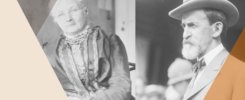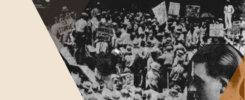Written and Performed by Justin Clark. Produced by Jill Weiss Simins.
The sound of the capacity crowd at Sydney Stadium on December 14, 1910 was deafening as two boxers in the prime of their careers duked it out. It was neck and neck the first three rounds, with Australian Frank Thorn and American Ray Bronson trading punishing blow after blow. In the fourth round, however, things shifted dramatically, when Thorn’s left arm shattered completely and “hung inert as the maimed wing of a bird,” wrote the Sydney Referee. Thorn’s team threw in the towel, and Bronson was declared the victor.
Known as the “Indianapolis Pugilist,” Ray Bronson fought in 81 bouts, with 48 wins and 22 Knock-Outs during his career. His skills in the ring gave him the opportunity of a lifetime. In the fall of 1910, legendary boxing promoter Hugh D. McIntosh brought Bronson and other boxers to Australia for an extended campaign. Australian boxing fans jumped at the chance to see him fight, with the Sydney Sundeclaring him the “most promising of the coming lightweights.” Of the six bouts during his 1910-11 Australian tour, he won three by knockout, two on points, and lost only once.
A one-time welterweight champion, Bronson would parlay his success into opening his own boxing club in Indianapolis and managing other promising boxers. Not too bad for a former horseshoer from Indiana.
I’m Justin Clark and this is a short episode of Talking Hoosier History. [ding]
Ray Bronson was born on August 2, 1887 in Webster City, Iowa. He lived in Indianapolis by 1900, and before he was a boxer, he made and fitted horseshoes. An apprentice of Indianapolis horseshoer Dennis Egan, young Bronson learned his craft and built up his physique, pounding and shaping metal. It was said that “there was never a horse too frisky for Ray to shoe.” He belonged to the International Journeymen Horseshoers and served as the Vice President of his local lodge until 1906, as a teenager!
He began boxing in 1905 at seventeen years old, racking up wins almost immediately. The Indianapolis News described Bronson’s budding prowess in detail:
Bronson apparently has all the requisites of a successful fighter. He has appeared in almost every boxing entertainment held in this city during the last two years and has nearly always won by the knockout route. He can weigh in at 120 pounds. A blacksmith by profession, he is as strong as a bull and has hands like a heavyweight. Although there has been a great deal of boxing in this city, the good fighters that have been developed are extremely rare.
He went professional in 1909. When he didn’t win by knockout or points, most of his bouts ended in a draw. For example, on January 22, 1909, Bronson fought Pennsylvania featherweight Jimmy Dunn to a draw in ten rounds. “Dunn seemed heavier and his work in the earlier rounds gave promise . . .,” reported the Hammond Times, “. . . But Bronson was the aggressor all the way.”
Let’s take a break from our story and pull back the curtain on our research process here.
I discovered Ray Bronson’s story when I was working on the National Digital Newspaper Program back in 2017. As a fan of the Rocky films who is fascinated by the history the boxing and wrestling, I found it exciting to write about Indianapolis’ own premier boxer. It was even more exciting to find, via digitized newspapers from the National Library of Australia, that he had fought in the outback at the height of his career. With that, I knew he’d be a great topic to explore.
Most of what we know about Bronson’s boxing career comes, unsurprisingly, from newspapers covering his fights and public appearances. In online repositories like Hoosier State Chronicles, among others, I searched his name and the names of his opponents, based on his fighting record I’d found online. This gave me a full picture of his career and public life.
But sometimes fleshing out a person’s biography, even someone as famous as Bronson was at the time, can be difficult for the years before or after their time in the public eye.
In fact, Bronson’s death is still kind of a mystery. Using census records, social security records, and state death indexes, we were able to determine that he died in 1948. But we haven’t determined the cause of his death or the exact date. When a trail goes cold, we historians become like detectives, piecing disparate sources together to come up with a reliable narrative. It’s vital never to leave any stone unturned.
Ok, let’s finish up our story. Round two! [ding ding ding]
It was a cold February day in Indianapolis in 1912 when Bronson took on veteran Philly fighter Young Erne for the welterweight championship. Despite their similar weights, the match-up wasn’t exactly even. Erne was “three years older than Bronson, three inches taller, and has been in the ring five years longer,” wrote the Indianapolis Star, while this was Bronson’s first fight in the welterweight division.
They fought the full ten rounds, with Bronson and Erne swapping the points lead nearly every round. As the Star wrote, “It was an exhibition of boxing that kept the fans on edge every step of the way, and they both cut out a pace that was so fast it was difficult to follow their lightning exchanges.” In the ninth round, Bronson wailed away on Erne and landed so many hits that his point lead became insurmountable. By the tenth round, he was the victor, becoming the new welterweight champion. He held the title for nearly a year, losing it on January 13, 1913 against Chicago’s Spike Kelly in Memphis, Tennessee.
In 1914, with his fighting career slowing down, he began devoting more of his energies to managing boxers. As the Tacoma Timesreported, “Ray Bronson, Indianapolis welterweight champion, [is] now managing Milburn Saylor. . . and has a number of crack battlers under his wing. . . .” Saylor became one of Bronson’s key fighters during his manager years. Under Bronson’s wing, Saylor secured many victories, including a knockout of New York fighter Leach Cross. Managing and promoting boxers became Bronson’s second life within the sport, providing him with a generous income.
Despite his success as a manager, he tried fighting one more time. On September 7, 1920, after nearly six years out of the ring, Bronson fought future hall-of-famer Jack Britton in Cedar Point, Ohio, who easily defeated the rusty Bronson.
Within a month, Bronson announced his formal retirement from boxing. As Chicago’s Collyer’s Eye reported, “Ray Bronson, welterweight, has retired from boxing to devote his time to managing football and basketball teams and promoting bouts.” His fighting days were over.
With a “young man’s clean-cut face” and a “horseshoe punch,” Ray Bronson rocked the boxing world during the early 20th century. His considerable wins, international bouts, and successful management of other boxers put him a cut above most fighters. He was also a Hoosier, with a Midwestern work ethic that buttressed his success in and out of the ring. As the Horseshoer’s magazine wrote in 1912, “The Horseshoer’s Union may well be proud of this boy, for every one [sic] in Indianapolis is.”
If you want to learn more about this topic read: “Ray Bronson: “The Indianapolis Pugilist,” by me at our blog. The link is in the show notes.
State historical markers are also a great way to learn about sports history. Head to our website and look for the marker on legendary Benton County racehorse Dan Patch!
The standard-bred colt was foaled and raised in Oxford, Indiana in 1896. In 1901, he debuted on the Grand Circuit in Detroit, where he became famous for never losing a race. He was later sold to Marion W. Savage, owner of International Stock Food Company in Minnesota, who used the horse’s fame to market his stock food and other products. Patch’s 1906 world record 1:55 mile held for a whopping thirty-two years! He retired in 1909.
We hope you liked this short episode of the podcast. Let us know! Subscribe, rate, and review us wherever you get your podcasts. Once again, I’m Justin Clark, and this has been Talking Hoosier History. Thanks for listening.
Show Notes
For sources, links, and images see: “The Agitator: Theodore Luesse Takes on the Great Depression” by Justin Clark on the Indiana History Blog.
This episode was written and performed by Justin Clark. Talking Hoosier History is produced by Jill Weiss Simins.



